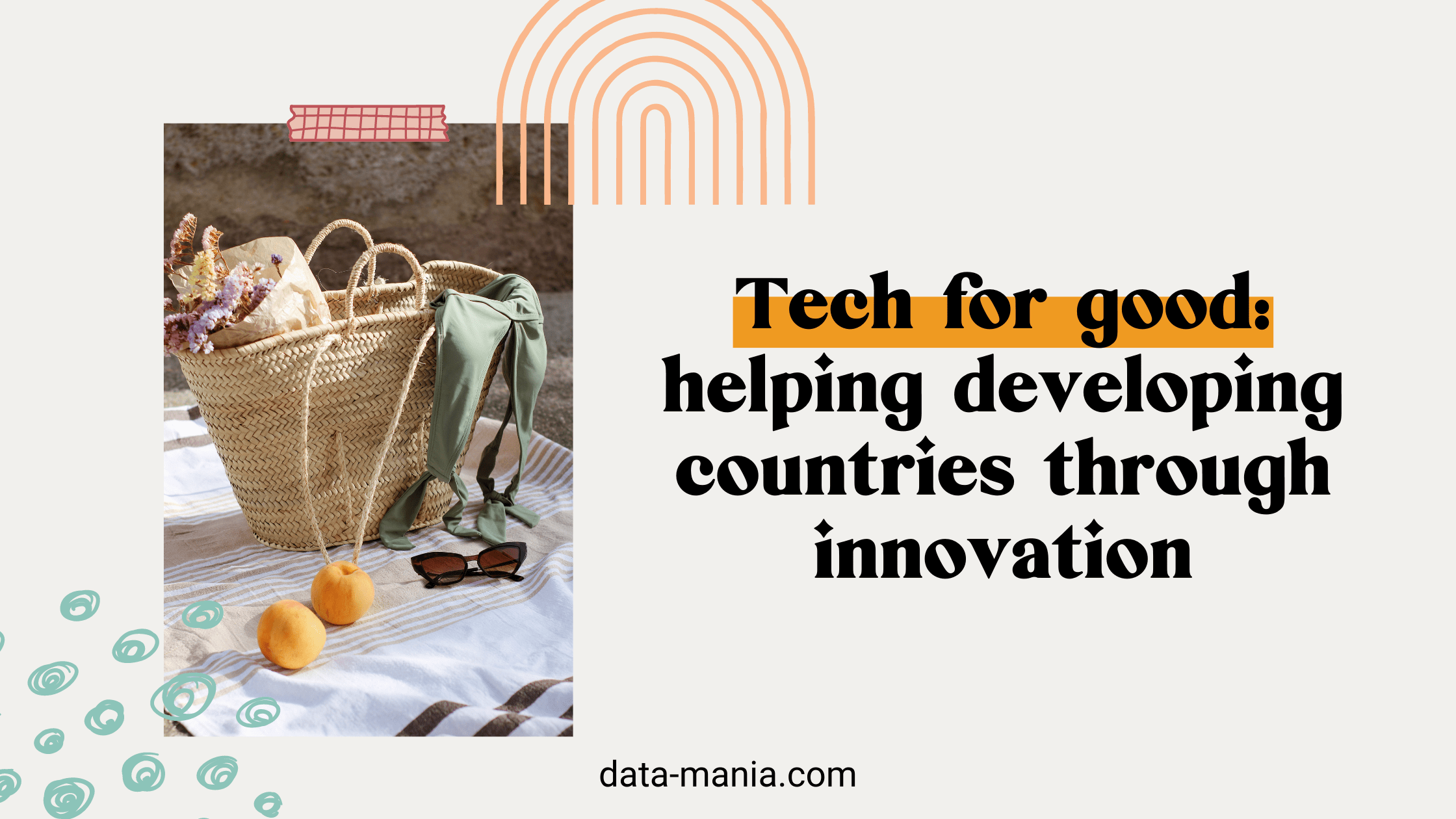
When we as data professionals engage with developing populations and help them access better technologies, we also benefit by gaining exposure to new strategies of application and implementation, develop problem-solving skills, generate positive press or media for our organizations, and learn from radically different perspectives and life experiences. In this blog post, you’re going to get a slew of best practices that you can use to guide you in developing a tech for good initiative.
Why Your Social Initiative Needs a Smart Design
We all know that technology advances create seismic changes, not only within communities but for countries and entire international ecosystems. However, these advances stem from resources and hubs of innovation that naturally cluster within countries of influence and wealth.
Oftentimes, those places considered “developing countries” don’t benefit from new technologies for years or even decades after they are available in more affluent places. Because of this, a huge opportunity exists for technological leaders and entrepreneurs to help upskill developing countries through innovative technology advances.
It’s probable that you’ll create unwanted adverse effects if your technological initiative is implemented poorly, whereas technological initiatives that are well designed and delivered enable developing countries to advance in critical areas of importance.
When done well, using tech for good can be a hugely important way of developing a country’s economic landscape as a whole as well as creating social good. Poor implementation of technological initiative may probably create unwanted adverse effects. However, well-designed and delivered technological initiatives enable developing countries to advance in critical areas of importance.
Social Impact and Developing Countries: A Snapshot
Social impact refers loosely to something’s effects on people, society, and communities, and specifically the pursuit of creating positive changes for those groups. Tech for good has become a forefront issue of interest in recent years. Many organizations, corporations, and countries that have influence and agency are pursuing (or pressured to pursue) methods of creating social impact for countries and populations that do not have the same access to resources. Doing this via technological means is a significant way of distributing agency and ability.
What exactly is a developing country? World Population Review defines a “developing country” as one that fits a set of multiple criteria developed by the United Nations. This assessment is referred to as the Human Development Index (HDI). The HDI looks at metrics such as the country’s economic growth, average life expectancy, population health, the state of education, and quality of life scores to develop a composite rating.
However, HDI is just one instrument to gauge a country’s development status. Another metric commonly employed is to calculate a country’s nominal gross national income (GNI) per capita. We use that figure sometimes as a quick alternative assessment to estimate a country’s level of development relative to others.
Ways Tech Can Be Deployed to Alleviate Common Problems in the Developing World
You can apply technology to just about any aspect of human existence. Because of this, using tech in specific ways to enact social impact is just about as broad. However, there are a few main focus areas that exist within the majority of tech-driven social impact projects.
EdTech Tech for Good
Education is one large area where technology can be applied to make a widespread difference for developing countries. This could take the form of strengthening internet connection, infrastructure, and capabilities for school facilities. It might look like supplying teachers, school systems, or institutions with computing hardware or goods. Developing and producing technologies or devices that are adapted to particular needs or specific environmental elements can be another way technological innovation can strengthen education in developing areas.
Increasing capacity for collecting insights and conducting data-driven decision making is another way technology can help developing countries. Equipping developing countries with more robust data capabilities and better intelligence training and frameworks can allow them to apply their resources more effectively, and improve the caliber of the strategic decisions their leaders make in directing the country. These tools can also be a helpful resource for its private sector.
Healthcare Tech for Good
Medicine, health, and disease prevention is another area where technology advances can create huge advantages for developing countries. Drugs, medical procedures and instruments, better training and public health awareness, and more can create fundamental changes for entire communities and people groups. As an example, treatments for diseases or medical conditions that historically ravaged populations have saved countless lives, impacted economies, and changed realities for huge numbers and even entire generations of people.
Technology’s impact on industry can also be far-reaching and create significant advancements for developing countries. Introducing new agricultural techniques and equipment, advanced machinery for various business types, better computing devices and software systems for managing businesses, and more can all help developing countries increase their production and efficiency and build their economies.
Transportation Tech for Good
Transportation is another area in which technology can create a lasting impact. Better alloys, building materials, manufacturing methods, design strategies, and know-how can contribute to better infrastructure. Improving public transportation methods and functionality can increase efficiency and make commuting and travel more available for more people. Green energy sources, more efficient vehicles and machinery, and other advances can help developing countries lessen pollution. They also reduce their reliance on crude oils and external regimes, and better protect their local flora and fauna.
Helping Well: Considerations for Responsible Tech Assistance Initiatives
If you as a data professional, technology entity leader, or entrepreneur are interested in developing an initiative to help bring your technology to a developing country, keep a few principles in mind while you are designing your endeavor.
As alluded to in the introduction, not every attempted technological social impact initiative (especially when exerted by an outside body) has gone well. In fact, trying to manufacture social impact through technology can often create ill effects on local people. It also affects organizations, populations, cultures, and more when not carried out in a thoughtful, well-researched, thought-out way. Consider a few when thinking or planning of a technological social impact intervention of any kind.
Be Ready for Unforeseen Effects and Unintended Consequences
Introducing new technologies into a process, a population, or a location will almost always create change. Hopefully, it will create the anticipated positive change. But too often, the introduction of new technologies into ecosystems formerly devoid of that technology creates unintended side effects that are difficult to predict. These can sometimes be benign or insignificant. But in some cases, they can be harmful or detrimental. It’s extremely important to do homework and take a slow, diligent approach to technological introduction. Your project should entail time, assessment, and unbiased observation that can monitor undesired effects.
Be Aware of International Standards
Standards for various aspects of technology differ from place to place. It’s naive to bring technology into a country that might be governed by different regulations or work according to different standards without researching first. Whether electrical realities like voltage or power grid considerations, differing data protection laws, or otherwise, make sure you have a strong understanding of any relevant technological realities that may affect your project when you deliver technology to a different country.
Be Mindful of Local Societal Norms, and (when possible) Support Demographics that Are Commonly Suppressed
In many parts of the world, stigmas or prejudices exist. They’re also often quite different than they may have been in your country of origin. For example, women are treated as secondary citizens in many places even though they can make capable innovators and partners in any industry or field if given the opportunity. Be aware of how the culture you’re entering operates and views different groups of people. And when in your power, champion social change to help those that don’t have the freedom or agency they should.
Take a Learning-First Posture
It’s easy for outsiders that come from more “advanced” societies or privileged life circumstances to assume they know best. However, the best technological social impact initiatives take a humble posture when introducing new technologies to developing countries. There are many reasons that make this the most appropriate way to conduct technological interventions. Some include preserving dignity for local people. It also includes making sure the opportunity to learn from that developing country’s way of life or existing methods remain forefront for your implementation team.
The Benefits to Your Team, Brand, and Product
Helping tackle a technological deficiency in a developing country can be an involved project. Ensure to design with care and a listening-first posture. This is to avoid the potential stumbling blocks and unhelpful outcomes alluded to above. You should not enter into these types of projects lightly – It’s important to do your homework. Make sure the project you have in mind is sustainable and something you can see all the way through.
Engaging with this type of technological project can produce several solid benefits mentioned at the beginning of this article. These include the following:
- A unique opportunity to strengthen your team’s culture. It also provides strong team building experience as they engage in the implementation process. The process can be in a foreign country or with a different people group.
- A noteworthy initiative to share with your audiences, consumers, and stakeholders that can benefit your brand.
- Opportunities to surmount unforeseen challenges and think creatively to navigate differences in resources, social norms, device and technology availability, and needs.
- A chance to think critically about your product, brand, and team that can help you strengthen any or all of these elements going forward.
The Future of Tech in Developing Countries
There will always be disparities amongst various countries around the world. This also applies to their ability to develop or harness cutting-edge technology within their borders. Through well-designed and implemented technological initiatives delivered by external bodies to create social impact, we can leverage technology worldwide. This also means we can create meaningful change for some of the most vulnerable populations on the planet.
A social impact project could provide you, your company, or your team with invaluable experience. Finally, it gives you growth opportunities, and helps you strengthen your product and your brand.
A Guest Post By…

This blog post was generously contributed to Data-Mania by Ryan Ayers.
Ryan Ayers is a researcher and consultant within multiple industries including information technology, blockchain and business development. Always up for a challenge, Ayers enjoys working with startups as well as Fortune 500 companies.
If you’d like to contribute to the Data-Mania blog community yourself, please drop us a line at communication@data-mania.com.









